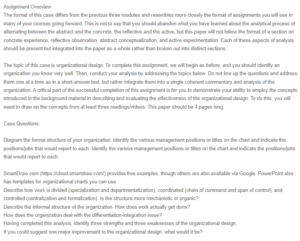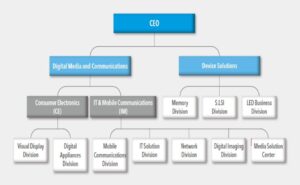Organizational Structure and Culture – Samsung
Samsung’s Organizational Structure
Sam has a product-type divisional organizational structure with three divisions, including IT and mobile communications (IM), device solutions (DS), and consumer electronics (CE) (Gadalla, 2020). The company’s classification into different divisions is due to its many product offers and differences among the products and services it offers in the market. The various divisions operate separately since the different products have different implications on new product development, marketing, selling, and other business aspects.
All employees at every level in Samsung are required to comply with orders from the CEO without challenging them. Lower-level managers have no authority to make decisions since the company has a centralized organizational structure (Gadalla, 2020). The decision chain at the company filters from the CEO down to lower-level management.
The board of directors sets the CEO’s responsibilities with respect to the relevant legal structure. Typical duties of the senior-most manager include decision making, director, leader, and executor. Such roles relate to guiding policy and strategy. Being a manager, the CEO also presides over the day-to-day running of the organization. The leadership role involves advising the board of directors, motivating employees, and driving organizational change.
Product-Type Divisions
Product type division is the main characteristic of Samsung’s organizational structure. Each product category represents the resources and operations that relate to a particular product category. For instance, the consumer electronics category delves into the production, distribution, and sale of consumer electronics. The company’s focus on new product development and technological innovation has gone a long way in helping the company attain its vision and mission (Chang, 2011). Samsung may merge, add, or disband divisions based on existing business needs, as the company is on constant expansion. As stated earlier, its product type divisions include consumer electronics, IT and mobile communications, and device solutions. Other divisional departments that form part of Samsung’s organizational structure are the corporate management office and the Samsung Institute of Advanced Technology.
Geographical Departmentalization
Samsung is a leading global company specializing in digital media, consumer electronics, semiconductors, and home appliances, among other products. That means that the company has a global presence in various regions and countries. There are 196 subsidiaries worldwide, categorized into research laboratories, distribution subsidiaries, and production and distribution subsidiaries (Chang, 2011). These subsidiaries require a comprehensive governance structure, although many organizational decisions occur in the head office in South Korea. Apart from the main office, subsidiary offices are in Latin America, North America, Europe, Southeast Asia, Southwest Asia, Africa, and CSI.
Globalization played a significant role in influencing Samsung’s geographical departmentalization. Lee Kun-Hee, Samsung’s former chairman, first came up with regional headquarters to aid the company’s global marketing strategy (Chang, 2011). Samsung uses its multiple subsidiaries to market different products to a diverse global market. Having these subsidiaries is essential in making critical decisions relating to product offers since customer needs differ globally. The presence of international subsidiaries has played a significant role in reducing the company’s production costs. Other growth patterns associated with the structure include market expansion, outsourcing opportunities, cheap labor, and resource availability.
Centralized Corporate Hierarchy
The centralized organizational structure relates to the primary office that makes critical decisions regarding the management of Samsung plc. The central organizational structure is crucial in making essential policy and strategic decisions that bypass the jurisdiction of regional managers. For instance, a decision like terminating the production of a non-performing product can only be made from the main office and not among regional offices. One notable decision on Samsung’s part is the recall of the Galaxy Note 7. Making such centralized decisions overburdens senior managers and quickens decision-making in other equally important business areas (Rangavittal & Sohn, 2008). The centralized decision-making organ helps low-level engineers who are too focused on product development notice gray areas in the entire business portfolio.
Samsung’s Informal Organizational Structure
There is no such thing as one-size-fits-all about Samsung’s organizational structure. Neither of the organizational structures discussed above can be used exclusively for a company of Samsung’s size to succeed. As a result, Samsung often has to operationalize the different organizational structures to stay competitive.
Samsung uses an adaptive design to eliminate red tape resulting from bureaucracies associated with traditional organizational structures. The global nature of Samsung’s operations means that the company encounters a competitive and dynamic business environment. If the company were to stick to the traditional bureaucratic system, it might lose a competitive advantage (Chang, 2011). Other than the organizational principles dictated by the head office, employees use the adaptive/organic design to respond to market needs. The advantage of the model is that it responds to changing market conditions in a market characterized by instability.
Integration-Differentiation Strategy
Like other Asian rivals, Samsung mainly focuses on the vertical integration strategy and a flood of products. The company participates in various product markets, including batteries, gaming systems, TVs, tablets, medical electronics tablets, smartphones, and cellphone carriers. Unlike rivals like Apple, which relies on competitors’ products, Samsung is primarily independent. The logistical integration enables the company to control the logistical uncertainty associated with the global market (Larentis, Antonello & Slongo, 2018). Samsung has a comprehensive differentiation strategy, as evidenced by its quality and relatively affordable products. For instance, Samsung’s smartphones have a better smartphone touchscreen, better camera, and more app compatibility, yet very affordable. These features have gone a long way in helping the company attain customer loyalty through satisfaction.
Strengths and Weaknesses of Samsung’s Organizational Design
One of Samsung’s key strengths is the ability to grow internally by leveraging the expertise of its divisions and subsidiaries. Such is achieved due to the exchange of ideas and technological innovations exchange among its divisions. The company’s conglomerate, for instance, is responsible for Samsung’s success in the semiconductors business. The synergic support among its divisions has aided its continuous growth. Also, Samsung has strong brands that respond to customer needs. The combination of Samsung’s centralized design and consumer-responsive products has given Samsung a competitive edge.
However, the organizational design also exposes Samsung to legal vulnerability. For instance, its US conglomerate has faced multiple lawsuits from the country’s main competitor, Apple (Tien, 2019). The fact that the central office controls Samsung subsidiaries exposes the company to organic legal suits.
Recommendations
The analysis of Samsung’s organizational design presents weaknesses that require innovative solutions to stay competitive. For instance, the company should exploit opportunities such as partnerships with strategic partners in the international market focusing on the consumer electronics area. The recommendation is based on the company’s lack of a comprehensive partnership strategy similar to Apple’s (Tien, 2019). Such partnerships will open previously unexploited opportunities in International markets that are limited to the company’s non-beholden design.
References
Chang, S. J. (2011). Sony vs Samsung: The Inside Story of the Electronics Giants’ Battle For Global Supremacy. John Wiley & Sons.
Gadalla, A. (2020). Samsung Management.
Larentis, F., Antonello, C. S., & Slongo, L. A. (2018). Inter-organizational culture: linking relationship marketing with organizational behavior. Springer.
Rangavittal, G. C., & Sohn, T. H. (2008). The impact and dynamics of centralization in supply chain decision-making (Doctoral dissertation, Massachusetts Institute of Technology, Engineering Systems Division).
Tien, N. H. (2019). International distribution policy comparative analysis between Samsung and Apple. International journal of research in marketing management and sales, 2020(1), 2.
Xu, R. (2009). Analysis of Samsung notebook strategy (Master’s thesis).
ORDER A PLAGIARISM-FREE PAPER HERE
We’ll write everything from scratch
Question
Assignment Overview
The format of this case differs from the previous three modules and resembles more closely the format of assignments you will see in many of your courses going forward. This is not to say that you should abandon what you have learned about the analytical process of alternating between the abstract and the concrete, the reflective and the active, but this paper will not follow the format of a section on concrete experience, reflective observation, abstract conceptualization, and active experimentation. Each of these aspects of analysis should be present but integrated into the paper as a whole rather than broken out into distinct sections.

Organizational Structure and Culture – Samsung
The topic of this case is organizational design. To complete this assignment, we will begin as before, and you should identify an organization you know very well. Then, conduct your analysis by addressing the topics below. Do not line up the questions and address them one at a time as in a short-answer test, but rather integrate them into a single coherent commentary and analysis of the organization. A critical part of the successful completion of this assignment is for you to demonstrate your ability to employ the concepts introduced in the background material in describing and evaluating the effectiveness of the organizational design. To do this, you will need to draw on the concepts from at least three readings/videos. This paper should be 4 pages long.
Case Questions:
Diagram the formal structure of your organization. Identify the various management positions or titles on the chart and indicate the positions/jobs that would report to each. Identify the various management positions or titles on the chart and indicate the positions/jobs that would report to each.
SmartDraw.com (https://cloud.smartdraw.com/) provides free examples, though others are also available via Google. PowerPoint also has templates for organizational charts you can use.
Describe how work is divided (specialization and departmentalization), coordinated (chain of command and span of control), and controlled (centralization and formalization). Is the structure more mechanistic or organic?
Describe the informal structure of the organization. How does work actually get done?
How does the organization deal with the differentiation-integration issue?
Having completed this analysis, identify three strengths and three weaknesses of the organizational design.
If you could suggest one major improvement to the organizational design, what would it be?


